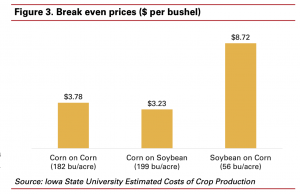Costs of Corn and Soybean Production
In a recent update from Iowa State University (ISU) Extension (“Estimating costs of crop production vital for 2020 farm businesses“), Alejandro Plastina explained that, “Thin profit margins in corn and soybean production have become the norm over the past five years, increasing the need for proper budgeting and marketing strategies among crop producers.”
The ISU update noted that, “On average, the total cost of corn and soybean production in Iowa is expected to decline by 4% from last year.”

Specifically, Dr. Plastina indicated that, “The estimated costs of production for continuous corn are $3.81, $3.78, and $3.76 per bushel for expected yields of 164 bushels per acre, 182 bpa, and 200 bpa, respectively. The estimated costs of production per bushel for corn following soybeans are $3.22, $3.23, and $3.23, assuming 179 bpa, 199 bpa, and 219 bpa, respectively.
“Cost of production estimates, per bushel, for herbicide-tolerant soybeans are $8.89, $8.72 and $8.57 assuming 50, 56, and 62 bushels per acre, respectively. The total cost per bushel of soybeans is projected at $8.72 for non-herbicide-tolerant beans at 56 bpa, according to the report.”
When breaking down the costs of production, the ISU update stated that, “For corn, land represents approximately 33% of the total costs of production…[and]…the variable costs represent just over half of the costs of production.”
“Land represents 45% of the total cost of production for soybean, while variable costs account for an additional 40%.”

With respect to breakeven prices, the Ag Decision Maker included the following graph, and pointed out that, “There is substantial uncertainty regarding crop prices in the coming season.”

Dr. Plastina added that, “Producers need to have a strong grasp of their own production costs. Costs of production are not seeing the rapid fluctuations that were seen in recent years, but the trade war and other events create a lot of uncertainty when it comes to profitability on individual operations.”
Source: Keith Good, Farm Policy News

